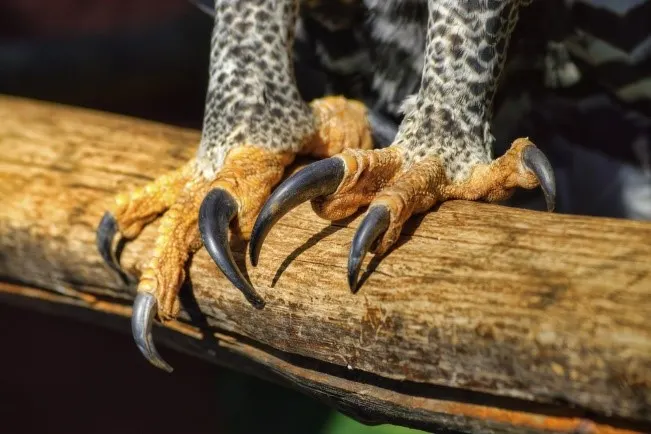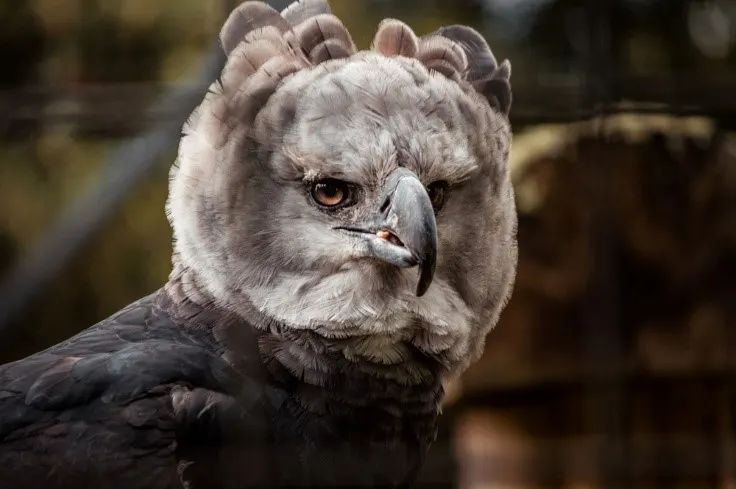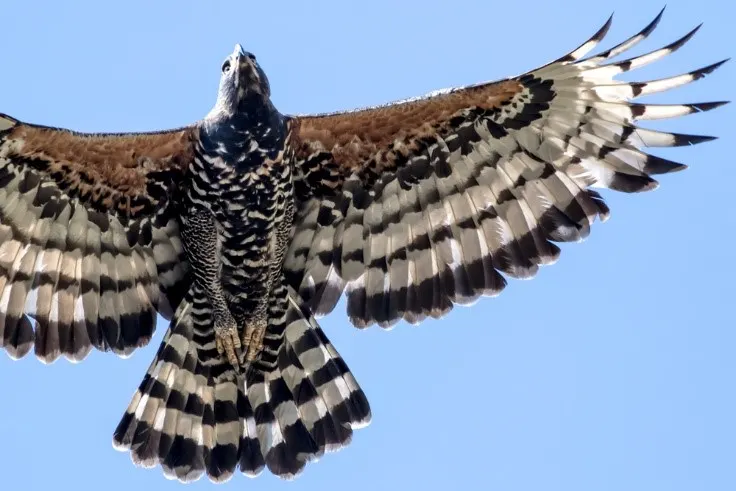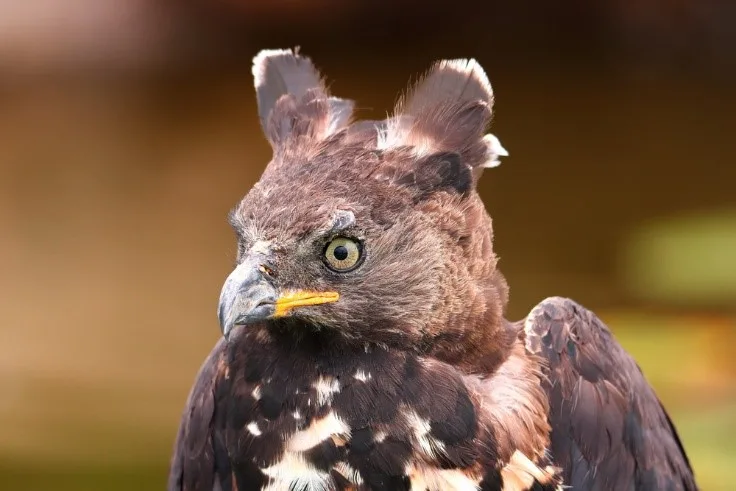The crowned eagle is also known as the African crowned eagle or the crowned hawk eagle. It is considered a large bird of prey found in Sub-Saharan Africa and a few other locations in South America.
This particular eagle species is threatened due to trapping, shooting, and nest destruction. In addition, they often face competition for prey from humans as well as habitat loss.
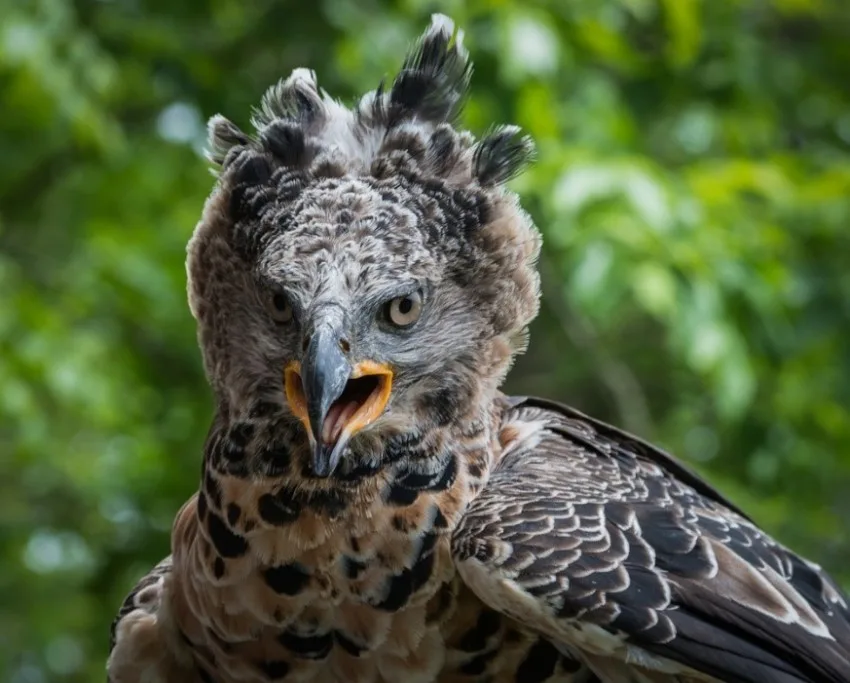
The crowned eagle symbolizes honesty, truth, majesty, strength, courage, wisdom, power, and freedom and are believed by many to have a special connection to God.
Read on for information about the crowned eagle, including its characteristics, diet, habitat, and facts you may not have known previously.
Crowned Eagle Stats
Status: Near Threatened
Known as: Crowned Eagle, Crowned Solitary Eagle
Scientific Name: stephanoaetus coronatus
Estimated numbers left in the wild: 5,000 to 50,000 and currently decreasing
Description of Crowned Eagle
Crowned eagles are large predatory birds with slate grey feathers and a visible crest. When measuring the crowned eagle size, you will find that these birds are 31 to 30 inches long.
A male crowned eagle size is typically between 7.1 and 10 pounds, while the female eagle weighs around 5.6 to 9.1 pounds. The crowned eagle wingspan is 5 to 5.9 feet.
The tail of this eagle species is striped boldly in black and white, though juveniles are duller and have plumage that includes quite a bit of brown. Adult eagles have a dark brown head and long crest feathers tipped in white.
You will also see a cream-colored or reddish breast with black bars. The wings are black on the top and a reddish color underneath.
Crowned Eagle vs Harpy Eagle
When comparing the African crowned eagle vs Harpy eagle, you will find several notable differences between the two. The African crowned eagle is considered to be a large and powerful bird of prey. The Harpy eagle is also large in stature, and some have even compared this bird species to a Pokemon because of its appearance.
Also known as the American Harpy Eagle or Brazilian Harpy Eagle, it is a neotropical eagle species and is a powerful raptor that can handle heavier prey. When learning about Harpy eagles, you will also likely come across the New Guinea Harpy Eagle. It is another large bird of prey endemic to tropical rainforests of New Guinea.
The Harpy eagle is considered the largest eagle globally, but the crowned eagle is known as the most powerful eagle. The Harpy eagle looks both serious and goofy and is found in rainforests around the globe. The crowned eagle’s most suitable habitat is limited to the eastern areas of South Africa.
The wings of the Harpy eagle are also shorter and stubbier compared to a crowned eagle wingspan. The Harpy actively hunts as a carnivore, and its main prey animals include tree-dwelling mammals like the sloth, monkeys, porcupines, anteaters, and opossums.
When comparing a crowned eagle nest to a Harpy nest, you will find that its construction differs depending on the habitat. The crowned eagle nest is similar to a Harpy nest as they are both considered burrow types.
The Harpy picks the highest point of a tree for its nest. In contrast, the crowned eagle nest is often located in a developed area with abundant larger prey. There is mature vegetation nearby to facilitate nest building and hunting activities.
See Related: Most Interesting Birds in the World
Diet of the Crowned Eagle
The habits of crowned eagles are different from those of many other eagles, including their apparent habit of being most active at dawn and dusk. Though crepuscular, it is sometimes active in the daylight hours, though it appears sluggish during the day much of the time.
Crowned eagles eat poisonous snakes and other snakes and large lizards as some of the mainstays of their diet, with mammals making up another major portion of their prey. Armadillos, monkeys, weasels, rodents, small antelope, and skunks are frequent prey animals of this large bird.
Birds are taken infrequently, with tinamou and monk parakeets being observed prey items, though domestic poultry is sometimes taken. The birds favor dry, open woodland and various kinds of grassland, as long as some trees are available for nesting.
Habit
Crowned eagles are known to live in forests, mountains, and grasslands in southeastern and Central Africa. They are the most powerful eagle in Africa and may hunt and live in pairs. These crowned eagle pairs were built to fly amongst the trees with their short and broad wings and a long tail that helps guide them.
The crowned eagle pairs will perform a series of steep dives and ascents, figure eights, and wing flaps at the top of their climb when showing territorial displays. While doing this, the male crowned eagle is noisy. He utters shrill screams while throwing his head back. The adult female may also engage in these display flights, but their vocalization is much lower.
The adult crowned eagle also blends well in dense and shaded forest habits, making it difficult to spot them when they are perched. They are most often seen soaring about the forest canopy. Since they are also considered territorial birds, they do not migrate.
Breeding and Mating Habits
The crowned eagle pairs build a large, conspicuous nest out of sticks, with the platform typically measuring around 1.2 meters in diameter.
Reproduction is slow, with only one egg laid during each breeding cycle. The exact timing of breeding and its specific details are uncertain, though eggs were present in some crowned eagle nests during an October survey, and young eagles were seen in the same nests the following May.
The crowned eagle remains relatively little studied due to its remote location and its sparse population.
The crowned eagle is monogamous and mates for life. The pair of eagles will typically breed once every two years or so. Their egg-laying times are often between the months of July and November.
The female crowned eagle gathers the nesting material, while the male crowned eagle is more involved in the actual construction of the nest. While the female is incubating, the male will bring food every three to five days.
If the female lays two eggs, the younger two typically die of starvation because it is outcompeted for food, or the older sibling kills the younger eagle.
The first feathers appear in 40 days. Also, once the young fledge is around 40 days old, it can then feed itself; however, it is often still fed by the mother at this point. It is then a young eaglet that remains in the care of the parents for another 11 months. They reach breeding maturity at around five years of age.
Location of the Crowned Eagle
Most crowned eagles live in Africa’s dense woodland forests and rainforests and are also found in Africa’s savannahs. They live from coast to coast across the central portion of Africa and the eastern side of the continent if you travel further south.
These birds of prey were built to fly among the trees. The distribution of the crowned eagle also spreads from southern Brazil to northern Patagonia in Argentina.
Other Crowned Eagle Facts
Here are some more facts about the crowned eagle you should know if you are interested in learning more about this large, predatory bird.
- Crowned eagles are very large and are considered the 9th heaviest living eagle species
- They are massive and fierce hunters that are also considered ferocious
- They are well-known for their spectacular feather displays
- It has been found that a crowned eagle can lift more than its own body weight in flight
- There have been discoveries of what to appear to be human skulls in their nesting sites, which spurred recorded instances of the bird taking off with children. It is the only living bird known to regard humans as large prey
Conservation Status
The current conservation status of the crowned eagle is Near Threatened. According to estimates, the amount of crowned eagles left is less than 10,000 birds, and this number continues to decrease.
Threats
Habitat destruction is the biggest threat to the crowned eagle today despite its extensive range.
Cattle ranching degrades the raptor’s habitat, especially the intensive type coming into common use in South America today.
Invasive grass species, mechanized agriculture, and pesticides are also taking their toll.
The birds are also persecuted to some extent, at least in some countries.
For example, dozens are known to have been shot in Argentina during recent years, while nests are sometimes deliberately disturbed or destroyed outright.
A few of these large birds are also captured each year to be sold illegally as exotic pets.
Related Reading: Philippine Eagle: Species Overview, Conservation, and Threats
Conservation Efforts
Argentina and Paraguay have given this bird protected status, though enforcement is always problematic. Hunting these birds is illegal in Brazil also.
Some conservation organizations are working to establish ecological corridors in critical regions to lessen habitat fragmentation.
There are also well-organized education initiatives, teaching ranchers that the eagles eat dangerous snakes and do not harm calves.
Organizations
The Peregrine Fund
The Peregrine Fund aims to reverse the current decline in the eagle population by conducting research and educating children from rural communities and farmers.
Zoo Conservation Outreach Group
The Zoo Conservation Outreach Group is helping by seeking funding to support crowned eagles’ rescue, rehabilitation, reintroduction, and monitoring in Argentina.
Crowned Eagle FAQ
Let’s look at the answers to some of the more commonly asked questions regarding the crowned eagle species.
What do you call a baby crowned eagle?
A baby crowned eagle is often referred to as an eaglet or young fledge. A bird is considered a young fledge when the feathers and wing muscles are developed enough for flight. If the bird has recently fledged but is still dependent on its parents for care and feeding, it is called a fledgling.
What class of animal does a crowned eagle belong to?
The crowned eagle is in the bird class and part of the Accipitridae family. It is considered the most powerful bird living in Africa.
How long does a crowned eagle live?
A crowned eagle can live up to 14 years.
What does the African crowned eagle sound like?
The sound of the crowned eagle in flight is described as a wheeee-yooo, wheeee-yooo, wheeee-yooo sound that draws attention.
How strong is an African crowned eagle?
Considered the most powerful bird in Africa, the crowned eagle can kill animals that weigh up to 44 pounds. Its long talons break the prey’s spine. To hunt, they sit in a tree that overlooks a watering hole or clearing, and then they drop in on their prey.
How fast can a crowned eagle fly?
When going for prey, a crowned eagle can swoop in at around 100 mph while still being able to brake within 20 feet of its prey. The bird uses its wings to push against the air currents and slow down.
What is the largest extant species of eagle?
The Harpy eagle is considered the largest extant species of eagle in the world. The Philippine Eagle is the largest eagle in the world when looking at its length and wing surface. In terms of weight, the Harpy eagle and Steller’s sea eagle are the largest birds.
What does a juvenile crowned eagle look like?
A juvenile crowned eagle looks different than an adult crowned eagle. It has the appearance of light gray and brown feathers on its back. Its wings are edged with white and make the bird appear to have scales. You will also find white on the head, breast, and belly of the juvenile crowned eagle and gray bars on its tail feathers.
Other Species Profiles
Related Resources

